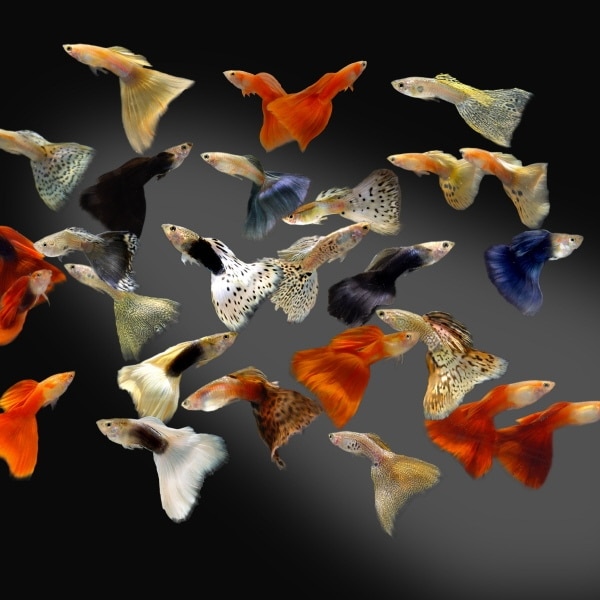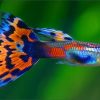Address
Center: Georgiou Theochari 4 Thessaloniki 54621
Kalamaria: Georgiou Papandreou 17A Thessaloniki 54645
Opening hours
Monday - Friday: 9am - 7pm
Saturday: 9am - 2:30pm
Address
Center: Georgiou Theochari 4 Thessaloniki 54621
Kalamaria: Georgiou Papandreou 17A Thessaloniki 54645
Opening hours
Monday - Friday: 9am - 7pm
Saturday: 9am - 2:30pm






POECILIS RETICULATA
Description
Guppies are the fish that almost every hobbyist has had in their aquarium at one time or another. They are considered as the fish of beginners and this is for two reasons: Firstly because there is an impressive variety of colours, essentially in the males, and because they have the peculiarity of being easy to spawn, which excites new hobbyists. At the same time they are one of the cheapest fish on the market and this makes them accessible to everyone. Secondly because they are much more hardy and adapt much more easily than many other species. However, because they are fish that come from repeated breeding, this ultimately makes them susceptible to different conditions than the ones they were born into. Adaptability is only seen in fish that are born in our own aquarium. These live longer and are less sensitive than those we buy.
Guppies belong to the family Poecilidae suborder Cyprinodontoidei class Atheriniformes. Their origin is from the region starting in Central America and extending to Brazil and the Caribbean. However, the fish found on the market that are from spawning, for the most part come from Asia, particularly Singapore. Fish caught in their natural habitat are very difficult to find on the market, and of course they are much more expensive. But today they are freely available all over the world, where the water temperature does not go below a certain limit. This has been done because they are ideal fish for mosquito control.
Due to the large area covered by their natural environment, there are many colour variations and with the crosses made by breeders, many more colours have emerged. Breeding them with target colour combinations is not an easy task. It takes a lot of experience to make a color species since it takes a lot of effort and proper selection of males and females for a correct result. There are groups all over the world that are dedicated exclusively to breeding these fish with amazing results many times. There are infinite colors and tail shapes that some experienced breeders have managed to achieve. Every year many exhibitions and competitions are organized in many countries with the sole purpose of exchanging experiences and breeding methods of these fish.
Unlike most fish species, guppies are very easy to tell the males from the females, except when they are very small. The males are smaller than the females and grow up to 3 cm. They are also thinner. But they have much more striking colours and a particularly large coloured tail. Like all zooids, they have an organ, the gonopod, which is also a characteristic feature to distinguish their sex. This is a conversion of the terrestrial wing into a reproductive organ that enables the male to fertilize the female internally. We need to know that as in many zooids, if the female mates once, this is enough to give birth more than once. The females are noticeably larger than the males. They reach 6 cm and are relatively indifferent in colour.
They are particularly peaceful fish that need to live in groups. It is recommended to put more females than males, because otherwise the males become very pushy to mate, and as a consequence they stress the females a lot, without interruption. They do not care for the young and usually eat them if there is no way to hide. It has been found that this behaviour has to do with their diet. There is the impression that they chase the young more if they are fed live food. They can be kept in a social aquarium with other zoopods such as Platys (Xiphophorus maculatus) and swordfish (Xiphophorus helleri), but also with small cichlids such as Apistogramma agassizii and A. cacatuoides, but this is not the best solution due to the water quality requirements of these fish.
They are fish that are very adaptable to the properties of the water. They can be kept in water with a pH of 5.5 to 8.5 and a hardness between 5 and 25 °dGH. The temperature can be between 18° and 28°C. They can withstand temperatures lower than 18°C (occasionally as low as 10°C) and well above 28°C, but thus do not live as long as at more moderate temperatures. The higher the temperature, the more intensive the metabolism of the fish. They grow faster, but live less. At 22°C - 23°C they grow more slowly, but live longer. The aquarium should be at least 40 cm long and have a capacity of 20 l. In addition, it should be planted with enough plants but also have free space for swimming.
They are not demanding in the matter of their diet.
| Weight | 1.5 kg |
|---|---|
| Manufacturer | Singapore |
Only logged in customers who have purchased this product may leave a review.
Reviews
There are no reviews yet